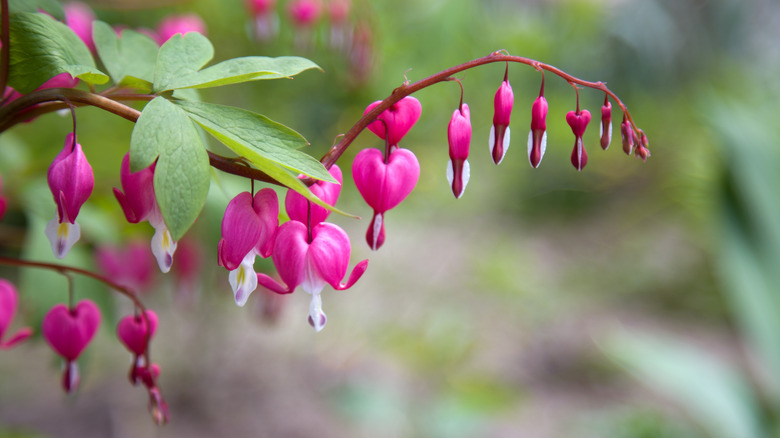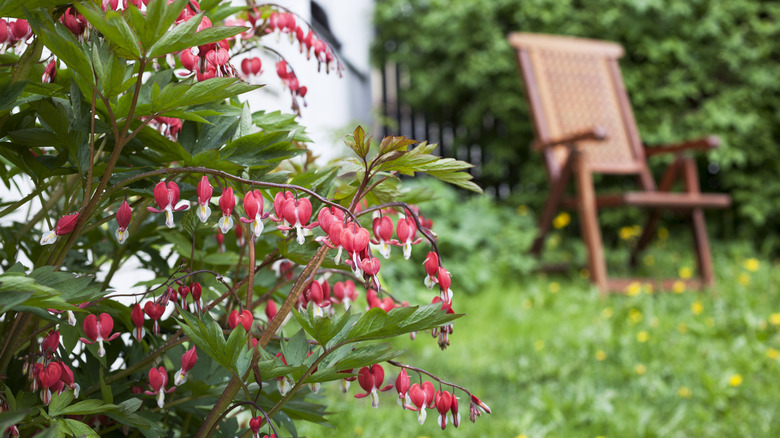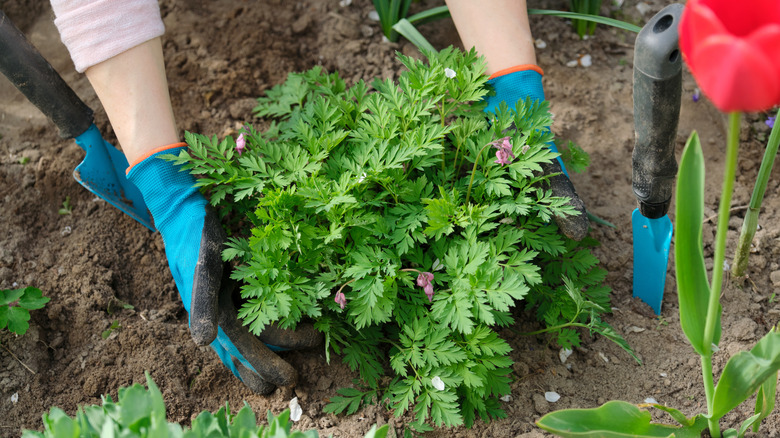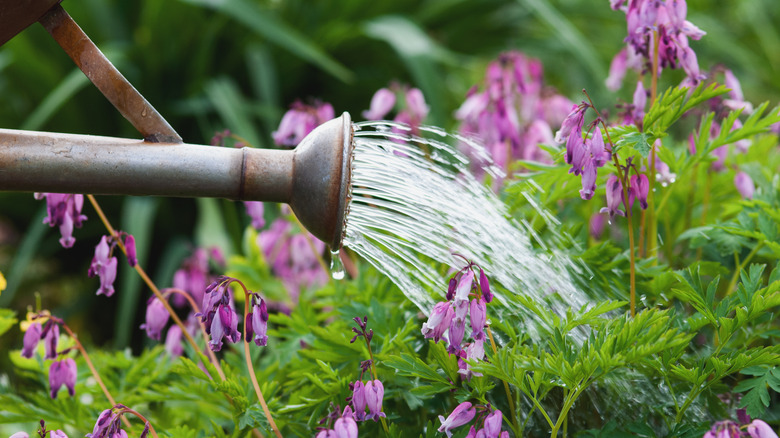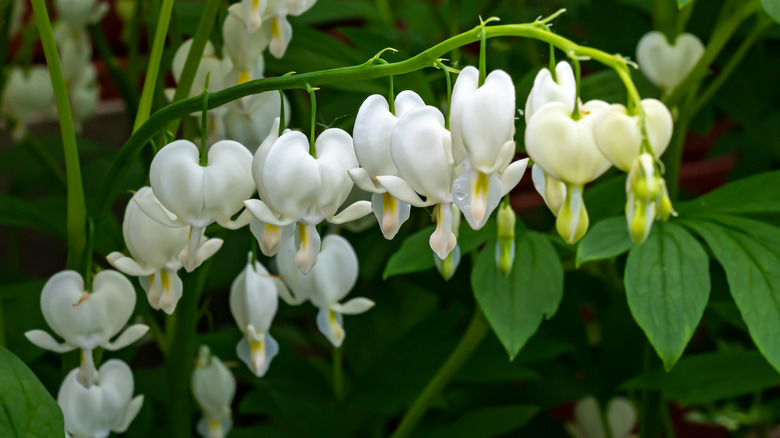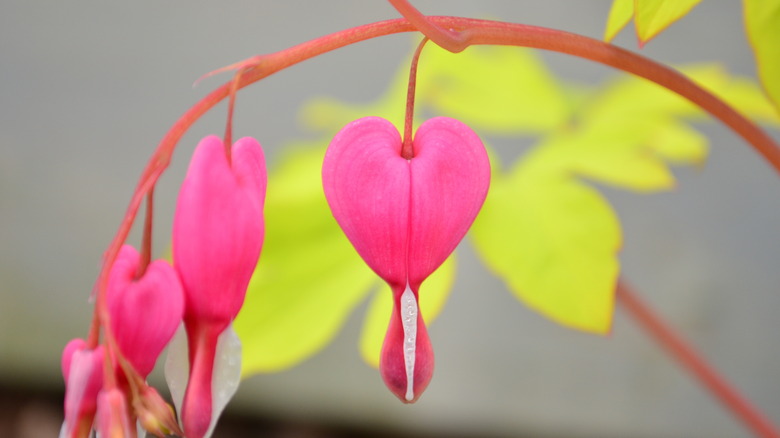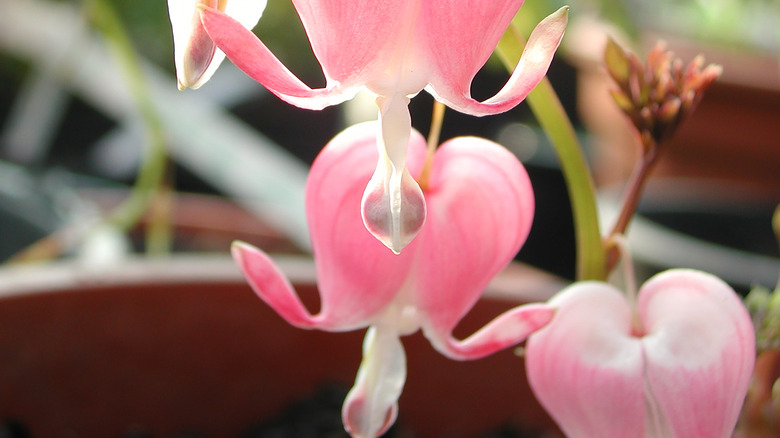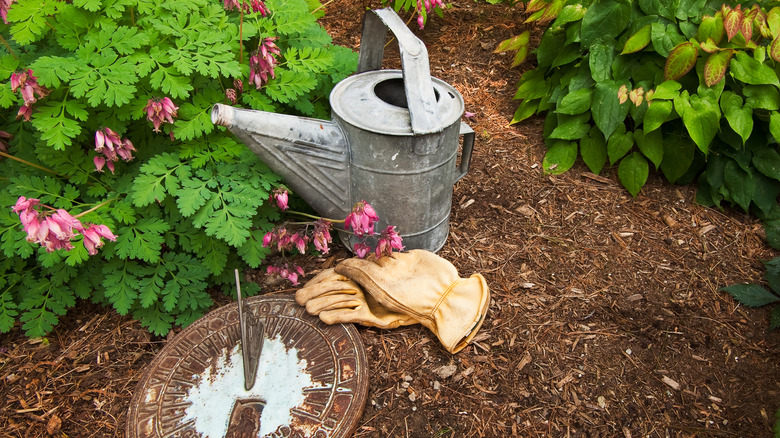How To Successfully Care For Your Bleeding Heart Plant
Poetic by name, enchanting by shape, the bleeding heart plant originated from the regions of Northern Asia, Japan, Korea, and Siberia. Bleeding heart (Lamprocapnos spectabilis), or Asian bleeding heart, is a rare plant within the poppy family of Papaveraceae. This herbaceous perennial is an outdoor favorite, as it prospers in a shady, forest environment. Bleeding heart decorated Chinese gardens for hundreds of years prior to Scottish botanist Robert Fortune's travels to China in 1846 (via the American Society for Horticulture Science). Uncertain if it was frost tolerant, the plant was often potted and placed inside. By 1878, bleeding heart was brought back outside in English gardens, and became one of the most popular plants to cultivate.
Renowned for its perfectly outlined heart-shaped flowers with emerging white blossoms, bleeding heart blooms for approximately six to eight weeks in spring (early May) and loves partial to full shade. On average, the plant grows up to 3 feet tall by 3 feet wide. With a creeping root stem, bleeding heart plants like rich soil that is both moist and well-drained. Almost provocative in appearance, the lovely, colored blooms dangle delicately along an arched vine. Many are seen in pink, red, and white colors.
This charming, old-world plant is one of a kind, as well as low-maintenance. The candylike heart-shaped plant may be used as a compress for various traumatic pain relief like bruises and sprains, per Alderleaf Wilderness College. Want to learn more about how to add bleeding hearts to your garden? Read on!
How to use bleeding heart in garden
Bleeding heart looks lovely nestling against a cottage or small structure, but it's essential to place it where there is predominant shade. With less light and more shadowing, your bleeding heart will be where it needs to be happy. If located further north, it can bear the heat of the full sun while in a colder environment. Whether it's in the front or backyard, plant it in humus-rich soil (organic material) that is neutral, yet slightly acidic. Add a 2- to 3-inch layer of soil and make sure it drains well. It won't be too picky about the pH level.
Since the bleeding heart blooms wither by summertime, you might want to place it near some deciduous plants. This way the life of your summer garden will continue, as your bleeding heart goes dormant during the winter. Successful plant companions are ferns, hostas, and "Jack Frost" (Brunner macrophylla genus), per Horticulture magazine. Also, a deciduous tree might assist with providing additional shade. What about propagation? If you want to expand the growth of your bleeding heart's vegetation, you can plant seeds, but using the method of propagation is the surefire way to do it, according to Gardening Know How. Dig up small clumps of the plant's roots, divide the soil, and replant where desired. This will prepare the "hearts" for their spring presentation and can be done every few years to follow.
How to grow bleeding heart
Although Asian bleeding heart can adapt and grow throughout various regions of the world, it flourishes best in cooler, temperate climates. Make sure to know the USDA Hardiness Zone for your place of residence, as bleeding heart thrives best in zones 3 through 9. Once you've established your zone, make sure your plant will receive plenty of shade, along with partial sunlight. It will grow in full sun, but in warmer, drier climates, it will require more shade. Planting bleeding heart is a simple process and is preferably done in the fall. This allows development to start naturally during the cold of the winter. It can also be done in spring to early summer, depending on the temperatures. For bleeding hearts to achieve mature size, plant your bulbs 2 to 2-1/2 feet apart in well-drained, moist soil; incorporate hearty, organic matter to initiate their growth.
According to Gardening with Charlie Nardozzi, it's more conventional to propagate bleeding heart from a neighbor or to purchase one at your local garden center. You can plant bleeding heart from seeds, yet it's a longer process. If so, place your seeds in a small pot of soil, then put it in a plastic bag and place it all in the freezer for six to eight weeks. From there, slowly acclimate them to warmer temps and sunlight to begin the germination process. Once they sprout, they'll be strong enough to transfer somewhere else.
How to care for bleeding heart
When it comes to watering your bleeding heart, irrigate it weekly with an inch of water to keep it regularly hydrated. Bleeding heart can be more drought resistant than the other Dicentra species, so the soil should be moist, never soggy. With other plants nearby, give it even more. This being said, bleeding heart is known to be susceptible to aphids, leaf spots, and powdery mildew. To resolve these issues, cut back the distressed areas and make sure to distribute water on the soil instead of the flora, as wet, shaded areas may boost fungal growth, per The Spruce. Also, look to remove any visible pests like snails or slugs, which are best found in the early light or in the peace of night.
Pruning is a major venture with most plants, but the main reduction to be made with bleeding heart is cutting back the foliage. Gardening Know How suggests trimming down the yellow and dead vegetation a few inches above the ground. Do this only after the leaves have weakened and faded, typically in early to midsummer. If done beforehand, the plant won't be able to store nutrients for the next season. The heat of summer will naturally fade them, turning to yellow. Regarding fertilizer, add a layer of organic compost to the topsoil to enrich it for next term. You could also enhance its development by including a time-release fertilizer. This can be done in the spring along with new growth.
Related species of the bleeding heart
What makes bleeding heart so unique? Originally labeled within the genus Dicentra spectabilis, botanists discovered in 2010 that bleeding heart is a sister to the family and can essentially possess a name for itself. Although bleeding heart is truly extraordinary, here are five species that are a close relative:
- Lamprocapnos spectabilis "Alba": Native to Japan, this garden favorite produces puffy, white, heart-shaped blossoms. Missouri Botanical Garden notes it is a late spring bloomer and grows approximately 24 to 36 inches by 18 to 24 inches wide.
- L. spectabilis "Gold Heart": This variety is known for its golden leaves and lovely pink, heart-shaped flowers. It blooms for four to six weeks in late spring to early summer and is deer and rabbit resistant.
- L. spectabilis "Valentine": An exquisite version that showcases a scarlet-red heart shape. The flowers can be included with a fresh bouquet and may last up to two weeks, notes Gardenia.
- Dicentra eximia, "Fringed Bleeding Heart": An American native, this bushy perennial showcases dangling, fringed-looking flowers with green foliage. Grows approximately 12 to 18 inches tall and wide while blooming to the end of summer.
- D. cucullaria, "Dutchman's Breeches": Native to the lush woods of North America. Blooms are white to pink and resemble a cluster of white breeches.
Is bleeding heart toxic?
Since bleeding heart is technically still a member of the Dicentra family, it contains a poisonous level of isoquinoline (poppy) alkaloids (via Plant Care Today). Although a stem of bleeding-hearts may look delectable as confection, they are not edible for humans or animals. Ingesting parts of the plant may cause mild to severe diarrhea and vomiting, including tremors and difficulty breathing, among other possible harmful symptoms. Similarly, the plant affects cats and dogs, as well as horses and other livestock. Overall, don't worry too much about any animals ravishing your bleeding heart growth, as it will also hinder deer and rabbits from getting close to it as well.
Being so pretty to look T, bleeding heart is not so nice to touch. Any part of the plant may cause skin irritation (rash), per American eBuilder. Wearing gloves when working in the garden with your bleeding heart vegetation is highly advised. Once again, pruning and deadheading are not necessarily a requirement since it will bloom again next season. Trim back the yellow and dead foliage as needed.
How to repot bleeding heart
Give your bleeding heart time to get established, at least two seasons. If it hasn't flowered within the first one, make divisions for further growth, suggests Gardening Know How. Divisions are generally made every three to five years. To transplant your entire plant, prepare your new site by shaking up the soil and digging a hole twice as large as the plant's root ball. Again, consider a location that offers plenty of shade in the afternoon along with soil that drains well. A good time is in early spring or the fall when the foliage has declined. Once transplanted, water it fully. Continue irrigation each day during the first week, then every other day the second week, and one to three times going forward.
Bleeding hearts can survive in most any container with the right amount of care. Since they can grow up to 3 feet tall, consider at least a 12-inch pot to start. When repotting, choose a pot of your choice that is one size up, then, add about 2 inches of fresh soil to the bottom. Secure the root ball in the center and fill it in with more soil accordingly. Finish by watering it thoroughly, and place it in a cool place, sheltered from the light, per The Spruce.
Overwintering bleeding heart
Bleeding heart is meant to withstand the cold temperatures of the enduring winter season. Even though the flowers and foliage may die off, they overwinter in the chilled underground in preparation for the spring. During this time, you might give special attention to keeping the rhizome (root ball) thriving. Do this by layering the stumps of the stems with a heavy deposit of mulch to protect them during this time of insulation, per Gardening Know How. This will advance the process more efficiently.
If you see any part of the root ball looking frail above the ground, don't worry — bleeding heart is exceedingly winter-tolerant and should survive the taciturn months following this method, according to The Spruce. Again, you may trim the stems down to 1 to 2 inches above the ground level and make sure to water it until the first frost. Once spring emerges, refresh the topsoil by removing the old mulch.
